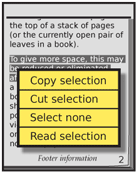|
Size: 5274
Comment:
|
Size: 5839
Comment:
|
| Deletions are marked like this. | Additions are marked like this. |
| Line 55: | Line 55: |
---- = Discuss & Add = Please do not change content above this like, as it's a perfect match with the printed book. Everything else you want to add goes down here. |
|
| Line 56: | Line 63: |
| If you want to add examples (and we occasionally do also) add them here. == Make a new section == Just like this. If, for example, you want to argue about the differences between, say, Tidwell's Vertical Stack, and our general concept of the List, then add a section to discuss. If we're successful, we'll get to make a new edition and will take all these discussions into account. |
Problem
Certain classes of users, or any user in certain contexts, must be able to consume content without reading the screen.
Solution
Mobile devices must be able to read text displayed on the screen, so it can be accessed and understood by users who cannot use the screen.
Due to mobiles being contextually employed, there are numerous instances in which the user may not be able to, not be allowed to, or may choose not to read the screen.
The user may well choose to use Voice Readback to allow themselves to use their hands and eyes for other purposes, in the way radio is used when video cannot be employed. For example, while working or performing hobbies which do not require excessive cognitive load themselves.

Variations
Universal - The entire interface is read, to allow the device to be used without any view of the display. This is usually combined with the Voice Input pattern to create a complete voice UI, as an alternative to the conventional button (or touch) and screen UI native to the device. Even if used for only one section, action, or phrase, this same method is used for any readback of voice commands.
Elemental - An entire document, such as a PDF, email or web page is read until the user cancels the action or the entire document is read.
Selected - A selection the user has specified within any context -- for example by highlighting text in a web page -- is read in it's entirety.
Voice output that is presented based on conditions, such as position or time, are discussed under the Voice Notifications pattern.

Interaction Details
Voice Readback can be turned on as a setting for the entire OS, or on an application basis. It will then be used automatically, whenever a change in the application is initiated.
Other input methods, such as keypads and Directional Controls will still function. Buttons will generally be needed to unlock or refresh a screen so that the current condition is read aloud.
Readback can also be initiated, for the Elemental and Selection variations, within the application or as a contextual control such as a Pop-Up, menu, Annotation or other control.
Readback for single-use cases of UI control is the result of Voice Input. Initiation is discussed under that pattern.

Presentation Details
Audio should be played through the external speaker, or speakerphone. The last set in-call volume (or equivalent playback volume for non-phones) should be used. Whenever possible, detect the ambient noise level and adjust the volume accordingly, in order to make it audible.
When a headset is attached (either physically or by a link such as Bluetooth), the playback should default to this device, and use the last set in-call volume for this device.
Content read must be identical to that printed on the screen. The condition that resulted in user employing Voice Readback may be temporary and transient; the user may switch between the screen and audio channels, or may even read along with the voice output. Even for users with a vision deficit, others may be accompanying them, who may also wish to use the device.
There may be delays between phrases, or before the start of the audio readback. To inform the user that audio is about to commence, and to prepare them for the volume level, a subtle tone should be played immediately beforehand.
A similar tone should be used when Voice Readback has completed for a significant time, or for the selected setting, to confirm this condition to the user. Otherwise they may be left guessing due to just
Antipatterns
Avoid mixing readback of commands and text. When the two must be used together, use delays, tones, changes in voice and clear syntax (such as "You said...") to indicate the difference.
The voice used must be as understandable as possible. Text-to-voice translation of names, especially, can be difficult to understand or improperly pronounced. If quality is too low with the available hardware and software, do not implement the solution.
Discuss & Add
Please do not change content above this like, as it's a perfect match with the printed book. Everything else you want to add goes down here.
Examples
If you want to add examples (and we occasionally do also) add them here.
Make a new section
Just like this. If, for example, you want to argue about the differences between, say, Tidwell's Vertical Stack, and our general concept of the List, then add a section to discuss. If we're successful, we'll get to make a new edition and will take all these discussions into account.
